最新生物技术专业英语教学内容
- 格式:ppt
- 大小:465.00 KB
- 文档页数:104

《生物技术专业英语与文献检索》课程教学大纲课程代码:课程名称:生物技术专业英语与文献检索课程类型:必修课总学时:36 讲课学时:36 实验学时:0学分:2适用对象:生物技术专业本科先修课程:一、课程性质、目的和任务《专业英语》是学生完成了两年基础英语学习后的一门后继课程。
通过指导学生阅读生物技术专业的英语书刊和文献,使他们进一步提高阅读和翻译科技英语的能力,并能以英语为工具获取专业所需的信息。
在科技领域,英语的重要性日益突出,生物技术领域尤为如此:生物技术领域的重要期刊,人都要求以英语发表;本领域国际会议都以英语为工作语言。
本课程的主要任务是:1.介绍生物技术专业词汇的基本构词法,帮助学生掌握一定数量的专业词汇;2.挑选生物技术领域的经典实验资料和学术论文讲解,培养学生对专业英语的阅读与写作能力。
《文献检索》是科学研究过程屮的最为关键的部分之一,非常耗费时间和精力。
据统计,传统的研究屮人约三分之一的工作吋间是在查阅资料・学习文献检索,即学习如何在最短的吋I'可内,以最有效的方式,查找到准确可靠的文献信息。
本课程的主要任务是要让学生掌握获取所需专业资料的种种检索方法和途径。
二、教学基本要求通过本课程的教学,要使学生能基本准确地阅读本专业的英语科技论文,掌握一•定数量的专业英语词汇,具备快速查询获得所需要的本专业屮英文文献的能力。
三、教学内容及要求《专业英语》授课学时Direct1. 熟悉专业词汇构词法(词根、前后缀等),掌握500〜800常用专业词汇。
2. 了解翻译理论知识,掌握务种翻译技巧,重点放在长句、复杂句及难句的翻译3.在规定时间内,能以规范、流畅、通俗易懂的译文语言翻译本专业文章。
《文献检索》 1.掌握学校购买的各种免费数据库的使用方法:CNKI 、Elsevier 公口 1的Science Online 和Springer 电子期刊。
2. 掌握网上免费的NCBI + PLBMED 和PMC 、GOOGLESCHOLAR 的使用方法。
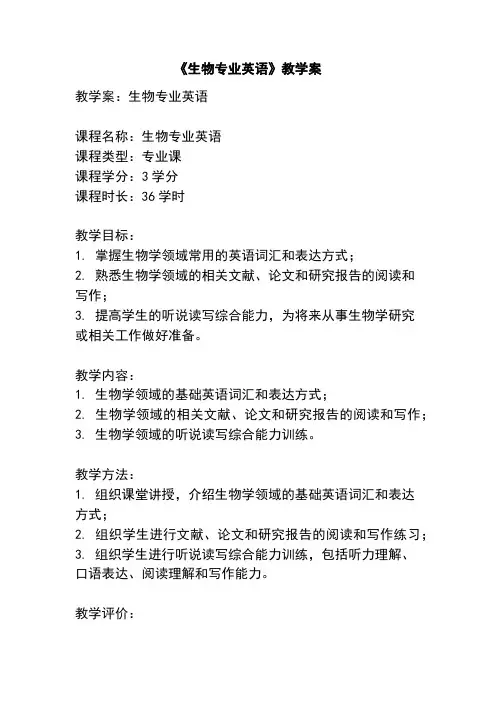
《生物专业英语》教学案教学案:生物专业英语课程名称:生物专业英语课程类型:专业课课程学分:3学分课程时长:36学时教学目标:1. 掌握生物学领域常用的英语词汇和表达方式;2. 熟悉生物学领域的相关文献、论文和研究报告的阅读和写作;3. 提高学生的听说读写综合能力,为将来从事生物学研究或相关工作做好准备。
教学内容:1. 生物学领域的基础英语词汇和表达方式;2. 生物学领域的相关文献、论文和研究报告的阅读和写作;3. 生物学领域的听说读写综合能力训练。
教学方法:1. 组织课堂讲授,介绍生物学领域的基础英语词汇和表达方式;2. 组织学生进行文献、论文和研究报告的阅读和写作练习;3. 组织学生进行听说读写综合能力训练,包括听力理解、口语表达、阅读理解和写作能力。
教学评价:1. 平时成绩占总评成绩的50%,包括课堂表现、作业完成情况等;2. 期末考试占总评成绩的50%,包括听力、口语、阅读和写作等方面的考核。
教学安排:第一周:介绍课程内容和教学目标,进行生物学领域的基础英语词汇和表达方式的讲解。
第二周:组织学生进行生物学领域文献、论文和研究报告的阅读练习,要求学生掌握阅读技巧和理解能力。
第三周:进行生物学领域听力训练,包括听取生物学相关讲座、演讲和讨论,并进行口语表达练习。
第四周:组织学生进行生物学领域的写作练习,包括摘要、实验报告和论文等的写作。
第五周:进行生物学领域的阅读理解练习,包括阅读和理解生物学相关文献和研究报告。
第六周:进行生物学领域的综合能力训练,包括听说读写的综合练习和模拟考试。
第七周:进行期末考试,包括听力、口语、阅读和写作等方面的考核。
第八周:总结课程内容和教学效果,进行学生评价和教师评价。
教学资源:1. 生物学领域的教材和参考书籍;2. 生物学领域的相关文献、论文和研究报告;3. 生物学领域的讲座、演讲和讨论录音或视频资料;4. 生物学领域的写作指南和范例;5. 听力、口语、阅读和写作练习题目和模拟试卷。

生物工程(生物技术)专业英语翻译Lesson One(4学时)Inside the Living Cell: Structure andFunction of Internal Cell Parts教学目的:使学生掌握细胞的组成结构(各种细胞器以及它们在细胞中的位置),Cytoplasm: The Dynamic, Mobile Factory细胞质:动力工厂Most of the properties we associate with life are properties of the cytoplasm. Much of the mass of a cell consists of this semifluid substance, which is bounded on the outside by the plasma membrane. Organelles are suspended within it, supported by the filamentous network of the cytoskeleton. Dissolved in the cytoplasmic fluid are nutrients, ions, soluble proteins, and other materials needed for cell functioning.生命的大部分特征表现在细胞质的特征上。
细胞质大部分由半流体物质组成,并由细胞膜(原生质膜)包被。
细胞器悬浮在其中,并由丝状的细胞骨架支撑。
细胞质中溶解了大量的营养物质,离子,可溶蛋白以及维持细胞生理需求的其它物质。
2The Nucleus: Information Central(细胞核:信息中心)The eukaryotic cell nucleus is the largest organelle and houses the genetic material (DNA) on chromosomes. (In prokaryotes the hereditary material is found in the nucleoid.) The nucleus also contains one or two organelles-the nucleoli-that play a role in cell division. A pore-perforated sac called the nuclear envelope separates the nucleus and its contents from the cytoplasm. Small molecules can pass through the nuclear envelope, but larger molecules such as mRNA and ribosomes must enter and exit via the pores.真核细胞的细胞核是最大的细胞器,细胞核对染色体组有保护作用(原核细胞的遗传物质存在于拟核中)。
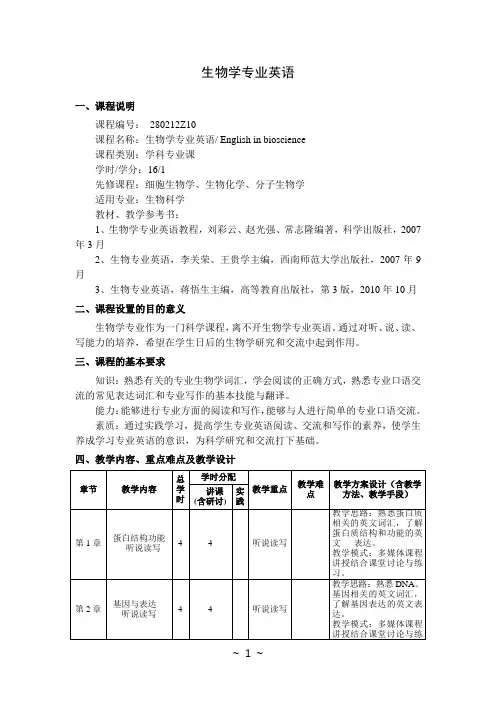
生物学专业英语
一、课程说明
课程编号:280212Z10
课程名称:生物学专业英语/ English in bioscience
课程类别:学科专业课
学时/学分:16/1
先修课程:细胞生物学、生物化学、分子生物学
适用专业:生物科学
教材、教学参考书:
1、生物学专业英语教程,刘彩云、赵光强、常志隆编著,科学出版社,2007年3月
2、生物专业英语,李关荣、王贵学主编,西南师范大学出版社,2007年9月
3、生物专业英语,蒋悟生主编,高等教育出版社,第3版,2010年10月
二、课程设置的目的意义
生物学专业作为一门科学课程,离不开生物学专业英语。
通过对听、说、读、写能力的培养,希望在学生日后的生物学研究和交流中起到作用。
三、课程的基本要求
知识:熟悉有关的专业生物学词汇,学会阅读的正确方式,熟悉专业口语交流的常见表达词汇和专业写作的基本技能与翻译。
能力:能够进行专业方面的阅读和写作,能够与人进行简单的专业口语交流。
素质:通过实践学习,提高学生专业英语阅读、交流和写作的素养,使学生养成学习专业英语的意识,为科学研究和交流打下基础。
四、教学内容、重点难点及教学设计
注:实践包括实验、上机等
五、实践教学内容和基本要求
学生参与(1)讲解分析有关专业课文或论文
(2)听力练习基本的生物学专业英语词汇
(3)生物学专业英语口语交流
(4)生物学专业英语写作与翻译。
六、考核方式及成绩评定
七、大纲主撰人:大纲审核人:。
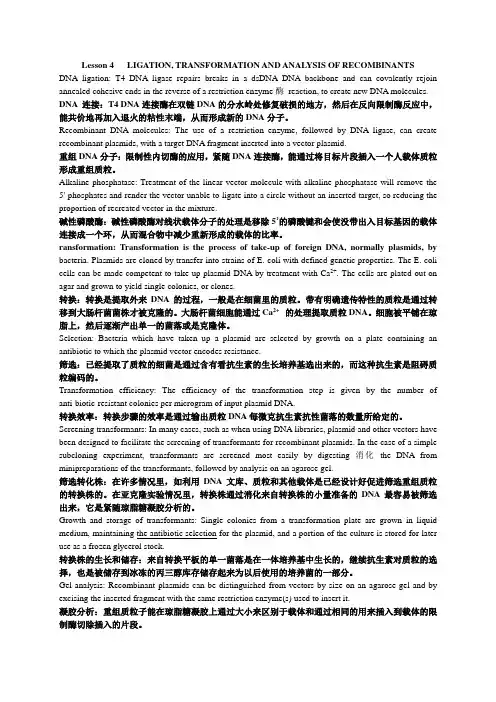
Lesson 4 LIGATION, TRANSFORMATION AND ANALYSIS OF RECOMBINANTS DNA ligation: T4 DNA ligase repairs breaks in a dsDNA DNA backbone and can covalently rejoin annealed cohesive ends in the reverse of a restriction enzyme酶reaction, to create new DNA molecules. DNA 连接:T4 DNA连接酶在双链DNA的分水岭处修复破损的地方,然后在反向限制酶反应中,能共价地再加入退火的粘性末端,从而形成新的DNA分子。
Recombinant DNA molecules: The use of a restriction enzyme, followed by DNA ligase, can create recombinant plasmids, with a target DNA fragment inserted into a vector plasmid.重组DNA分子:限制性内切酶的应用,紧随DNA连接酶,能通过将目标片段插入一个人载体质粒形成重组质粒。
Alkaline phosphatase: Treatment of the linear vector molecule with alkaline phosphatase will remove the 5'-phosphates and render the vector unable to ligate into a circle without an inserted target, so reducing the proportion of recreated vector in the mixture.碱性磷酸酶:碱性磷酸酶对线状载体分子的处理是移除5’的磷酸键和会使没带出入目标基因的载体连接成一个环,从而混合物中减少重新形成的载体的比率。


生物专业英语教学案生化技术与基因编辑一、引言在当今生物科技的迅速发展中,生化技术与基因编辑成为了生物专业非常重要的课题。
本文将介绍生化技术与基因编辑的基本概念、重要应用以及对教学实施的建议。
二、生化技术概述生化技术是通过应用化学和生物学原理来研究和改良生物体的技术。
它主要包括分子生物学、克隆技术、生物传感器等方面的内容。
生化技术既可以在基础研究中进行应用,也可以广泛应用于医药、农业、环境保护等领域。
三、基因编辑的基本原理基因编辑是指通过特定的技术手段对生物体的基因组进行精确的修改。
其中最常用的技术是CRISPR-Cas9系统。
该系统利用CRISPR引导RNA的导引作用,将Cas9蛋白引向目标基因组的特定位置,并通过Cas9蛋白的核酸酶活性切割DNA链,从而实现对基因组的定点改变。
四、基因编辑的应用1. 疾病研究与治疗通过基因编辑技术,科学家可以模拟人类疾病的发生机制,并开展相关的研究。
同时,基因编辑也为疾病的治疗提供了新的方法。
例如,通过基因编辑修复携带有疾病基因的干细胞,为疾病的治疗提供了新的可能性。
2. 农业改良基因编辑技术可以被应用于作物的改良,提高作物的抗病性、产量以及营养价值。
通过精确改变作物的基因组,农作物的品质和产量可以得到显著提升,为粮食安全和农业的可持续发展提供了新途径。
3. 动物模型研究基因编辑技术在动物模型的构建上也发挥了重要作用。
科学家可以通过基因编辑技术改变特定基因的表达,制作出适合研究特定疾病或生理过程的动物模型,有助于揭示疾病发生的机制以及开发相关治疗方法。
五、生化技术与基因编辑的教学实施建议1. 深入理论知识在教学中,首先应当对生化技术与基因编辑的基本原理和相关技术进行深入的讲解,使学生了解其背后的科学原理和应用价值。
2. 实验操作培训为了加强学生的实践操作能力,可以进行相关实验操作培训。
通过操作实验,学生可以更好地掌握生化技术与基因编辑的操作流程和技巧。
3. 理论与应用结合教学中应当注重理论知识与实际应用的结合。
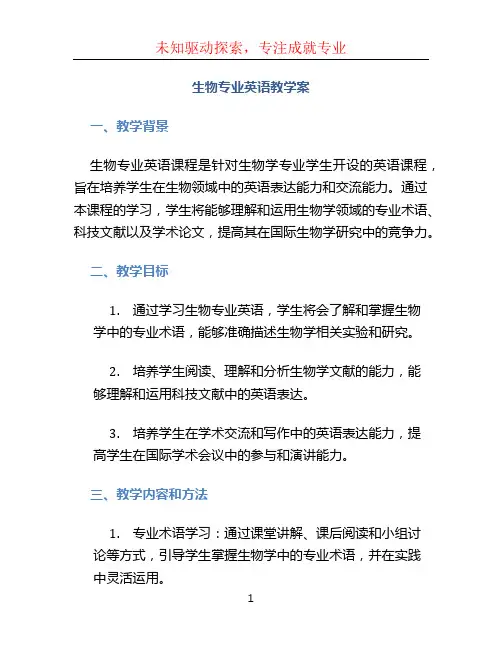
生物专业英语教学案一、教学背景生物专业英语课程是针对生物学专业学生开设的英语课程,旨在培养学生在生物领域中的英语表达能力和交流能力。
通过本课程的学习,学生将能够理解和运用生物学领域的专业术语、科技文献以及学术论文,提高其在国际生物学研究中的竞争力。
二、教学目标1.通过学习生物专业英语,学生将会了解和掌握生物学中的专业术语,能够准确描述生物学相关实验和研究。
2.培养学生阅读、理解和分析生物学文献的能力,能够理解和运用科技文献中的英语表达。
3.培养学生在学术交流和写作中的英语表达能力,提高学生在国际学术会议中的参与和演讲能力。
三、教学内容和方法1.专业术语学习:通过课堂讲解、课后阅读和小组讨论等方式,引导学生掌握生物学中的专业术语,并在实践中灵活运用。
2.科技文献阅读:通过分析和讨论科技文献,培养学生理解和分析生物学文献的能力,并通过写作和口头报告展示研究成果。
3.学术写作训练:通过给学生布置论文写作和报告写作任务,培养学生在学术写作中的英语表达能力,包括提纲撰写、引言撰写、方法和结果的描述等。
4.学术交流训练:通过模拟学术会议和小组讨论,培养学生学术交流和演讲的英语表达能力,加强学生的学术素养和自信心。
四、教学评价方法1.参与度评价:考察学生在课堂上的主动参与度、提问和讨论的积极性,通过课堂讨论、小组讨论和问答等形式进行评价。
2.作业评价:评估学生的作业完成情况,包括课后阅读、科技文献分析和论文写作等任务的完成情况和质量。
3.课堂测试评价:通过课堂测试考察学生对于专业术语的掌握程度和对科技文献的理解程度。
4.学术交流评价:通过模拟学术会议和小组讨论的方式进行评价,考察学生在学术交流和演讲中的英语表达能力。
五、教学资源和参考资料1.《生物学英语教程》(第二版),作者:杨春燕,出版社:清华大学出版社,年份:2018年。
2.《英语科技文献写作与翻译》(第二版),作者:王翠春,出版社:高等教育出版社,年份:2019年。

《生物技术》全英班课程教学大纲Introduction to Biotechnology适用对象:本科药学专业(全英班)学分:2 学时:总共36 , 24课堂讲授+12实验课程属性:专业选修课开课单位:华侨大学生物医学学院先修课程:生物学、药学相关课程I. Course aims and objectives:Biotechnology course is an introductory course that covers modern biotechnology development and applications for student biology, pharmaceutics and other related subjects. The aim of this course is to offer students to comprehend the basic mechanisms, technology and methodology of biotechnology. And let the students to be familiar with the applications and achievements of biotechnology in life science research, agriculture, food, human health, energy and environment science, et al. To help the students to know about the impacts of biotechnology on human society, expand their knowledge on the protection of biotechnology innovation and invention, as well as bio-safety policy both in China and abroad.Through study of basic knowledge, the course will enable student to master basic concepts and research methods in biotechnology, and combine with their background knowledge, helping them to think and study. It is expand contents for future work in pharmaceutics research and production.II. Course contents and requirements (include chapter aims, basic teaching context and teaching requirements):Modern biotechnology is an interdisciplinary science, its knowledge frombiology, medical science, physics, chemistry, mathematics, computer science and engineering. In this course, our specific teaching context are:1. The biotechnology century and its workforceAims and objectives:Master: basic concepts of biotechnology, Be proficient in: Types of biotechnology, Comprehend: the future development of biotechnology.Contens: Concepts of biotechnology, History of biotechnology, Biotechnolgy as an nterdisciplinary science, Ethics and biotechnology, Types of biotechnology and their research contents, The future of biotechnology and impacts on the society.2.An Introduction to Gene and Genomics:Aims and objectives:Master: Cell structure; The process of DNA replication, transcription and Translation. Be proficient in: The structure of nucleotides, DNA molecules and chromosomes. Comprehend: The concept of gene; Types of gene mutation and their Causes and Consequences.Contens: Comparison of Prokaryotic and Eukaryotic Cells; Evidence that DNA is the Inherited Genetic Material; The Structure of DNA, Nucleotide and Chromosome; DNA Replication; Genome; The Process of RNA and Protein Synthesis; SiRNA and their functions; Gene Expression Regulation at Different Levels; Types of Mutations and Their Causes and Consequences.3. Recombinant DNA Technology and GenomicsAims and objectives:Master: Basic Concepts of DNA Recombination Technology and Methodology; Technologies for Identifying and Cloning of a Gene of Interest; Be proficient in: Practical Features of DNA Cloning Vectors; Genomic Libraries and Cloning a Gene of Interest. Comprehend: Laboratory Techniques for Studying Gene Expression; Applications of Recombinant DNA Technology; Concepts and Applications of Genomics and Bioinformatics.Contens: Introduction to Recombinant DNA Technology and DNA Cloning; Restriction Enzymes and Plasmid DNA Vectors; Transformation of Bacterial Cells and Selection of recombinant bacteria after transformation; Practical Features of DNA Cloning Vectors; Identify and Clone a Gene of Interest; Genomics Library Preparation;PCR; Applications of Recombinant DNA Technology; Agarose Gel Electrophoresis and Restriction Mapping Gene Structure; DNA Sequencing Technologies; Chromosome Location and Copy Number; Laboratory Techniques for Studying Gene Expression; Concepts and Applications of Genomics and Bioinformatics; The Human Genome Project and Its Impacts.4. Protein as ProductsAims and objectives:Master: Protein Structure; Protein Purification and Verification. Be proficient in: Preserving Proteins; Scaling up protein purification and Postpurification analysis methods. Comprehend: Types of Protein Products; Concepts of Proteomics; Applications of Proteins.Contens: Applications of Protein in Biotech Drugs and other medical applications, Food Industry, Textiles and leather goods, Detergents, Bioremediation; Protein Structure, Protein Folding, Glycosylation; Protein Engineering; Protein Purification Methods; Protein Purification and Verification; Preserving Proteins; Scaling up protein purification and Postpurification analysis methods; Proteomics. 5.Microbial BiotechnologyAims and objectives:Master: the Structure of Microbes ;Microorganisms as Tools; Antibodies; Vaccines and Vaccines production; Using Microbes for a Variety of Everyday Applications ; Be proficient in: Microbial Diagnostics and Microbial Genomes. Comprehend: Microbial and the Combating Bioterrorism.Contens: The Structure of Microbes; Microbial Enzymes; Calcium Chloride Transformation; Using Microbes for a Variety of Everyday Applications; Cloning and Expression; Vaccines and Vaccines production;Sequencing the entire genomes of Viral; Viral Genomics; Microbial Diagnostics; Bacterial Detection Strategies; Microbial and the Combating Bioterrorism.6.Plant BiotechnologyAims and objectives:Master: Methods Used in Plant Transgenesis; Be proficient in: Practical Applications and Health and Environmental Concerns. Comprehend: Social problems bring by Biotechnology .Contens: Plant Biotechnology and Agriculture; Conventional Selective Breeding and Hybridization, Cloning, Protoplast fusion, Leaf fragment technique, Gene guns, Chloroplast engineering, Antisense technology; Practical Applications in the Field: Vaccines for plants, Genetic pesticides, Herbicide resistance, Enhanced nutrition, The future: from pharmaceuticals to fuel, Metabolic engineering; Health and Environmental Concerns.7. Animal BiotechnologyAims and objectives:Master: Basic Concepts of Animal Biotechnology and Cloning; Be proficient in: Animal Models and Animals in Research; Transgenic Animals; Producing Human Antibodies in Animals . Comprehend: Laws and Regulations of Animals Research; The limitations and Prospects of Cloning.Contens: Basic Concepts of Animal Biotechnology; Animal Models and Alternatives to Animal Models; Laws and Regulations of Animals Research; Animal Cloning and Applications; The Limits to Cloning and The Future of Cloning; Transgenic Animals and Applications; Producing Human Antibodies in Animals.8. DNA Fingerprinting and Forensic AnalysisAims and objectives:Master: DNA Fingerprinting and Forensics; Preparing a DNA Fingerprint; Be proficient in: Putting DNA to Use, DNA and the Rules of Evidence, Familial Relationships and DNA Profiles. Comprehend: Nonhuman DNA Analysis.Contens: Concepts of DNA Fingerprinting; Preparing a DNA Fingerprin; Application of DNA Fingerprinting; DNA and the Rules of Evidence, Familial Relationships and DNA Profiles: Mitochondrial DNA and Chromosome Analysis, Nonhuman DNA Analysis.9. BioremediationAims and objectives:Master: What Is Bioremediation and the Basics of Bioremediation. Be proficient in: Cleanup Sites and Strategies; Applying Genetically Engineered Strains to Clean Up the Environment. Comprehend: Environmental Disasters: Case Studies in Bioremediation; Challenges for Bioremediation .Contens: Concepts of Bioremediation; The Basics of Bioremediation; CleanupSites and Strategies; Applying Genetically Engineered Strains to Clean Up the Environment and Environmental Disasters; Case Studies in Bioremediation; Challenges for Bioremediation.10. Aquatic BiotechnologyAims and objectives:Master: Molecular Genetics of Aquatic Biotechnology; Be proficient in: Aquatic Biotechnology, Aquaculture. Comprehend: Genetic Technologies and Aquatic Organisms, Nonmedical Products, Environmental Applications of Aquatic Biotechnology.Contens: Introduction to Aquatic Biotechnology; The Economics of Aquaculture, Innovations in Fish Farming, Improving Strains for Aquaculture, Enhancing Seafood Quality and Safety, Barriers and Limitations to Aquaculture, The Future of Aquaculture; Genetic Technologies and Aquatic Organisms: Discovery and Cloning of Novel Genes and Genetic manipulations of Finfish and Shellfish, Medical Applications of Aquatic Biotechnology, Nonmedical Products, Environmental Applications of Aquatic Biotechnology: Antifouling agents, Biosensors, Environmental Remediation.11. Medical BiotechnologyAims and objectives:Master: The Power of Molecular Biology: Detecting and Diagnosing Human Disease Conditions, Gene Therapy; Be proficient in: Medical Products and Applications of Biotechnology, The Potential of Regenerative Medicine.Contens: Models of Human Disease; Biomarkers; Biomarkers for Disease Detection; Detecting Genetic Diseases; Gene Therapy; Cell and Tissue Transplantation; Tissue Engineering; Stem Cell Technology; Cloning and Regulations; Human Genome Project and Regenerative Medicine.12. Biotechnology RegulationsAims and objectives:Master: The Regulatory Framework of Biotechnology; Introduction to Patents of Biotechnology.Be proficient in: International Biotechnology Regulation and Legislation and Regulation: The Ongoing Role of Government; Global biotechnology products.Contens: The Regulatory Framework of Biotechnology,i nternational Biotechnology Regulation and Legislation and Regulation: The Ongoing Role of Government; The Patents of Biotechnology; Global biotechnology products.13. Ethics and BiotechnologyAims and objectives:Master: What Is Ethics and Relationship with Biotechnology; Be proficient in: Biotechnology and Nature. Comprehend: Economics, The Role of Science, and Communication.Contens: Ethic and Biotechnology;Regulations in Biotechnology research; Economics, The Role of Science, and Communication.III. Key Points and Difficult Points1. The biotechnology century and its workforceKey Points: Concepts of biotechnology; History of biotechnology basic concepts of biotechnology; Biotechnolgy as an nterdisciplinary science; Types of biotechnology and their research contents; The future of biotechnology and impacts on the society.Difficult Points: Ethics and biotechnology; The future of biotechnology and impacts on the society.2.An Introduction to Gene and GenomicsKey Points: Comparison of Prokaryotic and Eukaryotic Cells; Evidence that DNA is the Inherited Genetic Material and The Structure of DNA; The Structure of Chromosome, DNA Replication and the Genome; The Process of RNA and Protein Synthesis; SiRNA and their functions; Gene Expression Regulation at Different Levels; Types of Mutations and Their Causes and Consequences.Difficult Points: Evidence that DNA is the Inherited Genetic Material and The Structure of DNA; The Structure of Nucleotide; SiRNA and their functions; Gene Expression Regulation at Different Levels; Types of Mutations and Their Causes and Consequences.3. Recombinant DNA Technology and GenomicsKey Points: Basic Concepts of DNA Recombination Technology and Methodology; Restriction Enzymes and Plasmid DNA Vectors; Transformation of Bacterial Cells and Selection of recombinant bacteria after transformation; Practical Features of DNA Cloning Vectors; Identify and Clone a Gene of Interest; Genomics Library Preparation; PCR; Applications of Recombinant DNA Technology; Agarose Gel Electrophoresis and Restriction Mapping Gene Structure; DNA Sequencing Technologies; Chromosome Location and Copy Number; Laboratory Techniques for Studying Gene Expression; Northern and Real-time PCR; Concepts and Applications of Genomics and Bioinformatics; The Human Genome Project and Its Impacts.Difficult Points: PCR; DNA Sequencing Technologies; Northern and Real-time PCR.4. Protein as ProductsKey Points: Applications of Protein in Biotech Drugs and other medical applications, Food Industry, Textiles and leather goods, Detergents, Bioremediation; Protein Structure, Protein Folding, Glycosylation; Protein Engineering; Protein Production; Protein Purification Methods; Protein Purification and Verification; Preserving Proteins; Scaling up protein purification and Postpurification analysis methods; Proteomics.Difficult Points: Protein Structure, Protein Folding, Glycosylation; Protein Purification Methods; Scaling up protein purification and Postpurification analysis methods; Proteomics.5.Microbial BiotechnologyKey Points: The Structure of Microbes; Microbial Enzymes; Calcium Chloride Transformation; Using Microbes for a Variety of Everyday Applications; Antibodies; Vaccines and Vaccines production; Sequencing the entire genomes of Viral; Viral Genomics; Microbial Diagnostics; Bacterial Detection Strategies; Microbial and the Combating Bioterrorism.Difficult Points: Cloning and Expression; Vaccines and Vaccines production;Sequencing the entire genomes of Viral; Viral Genomics; Microbial Diagnostics; Bacterial Detection Strategies.6.Plant BiotechnologyKey Points: Plant Biotechnology and Agriculture; Methods Used in Plant Transgenesis: Conventional Selective Breeding and Hybridization, Cloning, Protoplast fusion, Leaf fragment technique, Gene guns, Chloroplast engineering, Antisense technology; Practical Applications in the Field: Vaccines for plants, Genetic pesticides, Herbicide resistance, Enhanced nutrition, The future: from pharmaceuticals to fuel, Metabolic engineering; Health and Environmental Concerns.Difficult Points: Methods Used in Plant Transgenesis7. Animal BiotechnologyKey Points: Basic Concepts of Animal Biotechnology; Animal Models and Alternatives to Animal Models; Laws and Regulations of Animals Research; Animal Cloning and Applications; The Limits to Cloning and The Future of Cloning; Transgenic Animals and Applications; Producing Human Antibodies in Animals.Difficult Points: Animal Cloning and Applications; Transgenic Animals and Applications.8. DNA Fingerprinting and Forensic AnalysisKey Points: Concepts of DNA Fingerprinting; Preparing a DNA Fingerprin; Application of DNA Fingerprinting; DNA and the Rules of Evidence, Familial Relationships and DNA Profiles: Mitochondrial DNA and Chromosome Analysis, Nonhuman DNA Analysis.Difficult Points: Concepts of DNA Fingerprinting; Familial Relationships and DNA Profiles.9. BioremediationKey Points: Concepts of Bioremediation; The Basics of Bioremediation; Cleanup Sites and Strategies; Applying Genetically Engineered Strains to Clean Up the Environment and Environmental Disasters; Case Studies in Bioremediation;Challenges for Bioremediation.Difficult Points: Applying Genetically Engineered Strains to Clean Up the Environment10.Aquatic BiotechnologyKey Points:Introduction to aquatic biotechnology; The Economics of aquaculture; Fish-Farming Practices; Improving Strains for Aquaculture; Enhancing Seafood Quality and Safety; Barriers and Limitations to Aquaculture; Genetic Technologies and Aquatic Organisms; Discovery and Cloning of Novel Genes; Genetic Manipulation of Fish and Shellfish; Medical Applications of Aquatic Biotechnology; Environmental Applications of Aquatic BiotechnologyDifficult Points: Discovery and Cloning of Novel Genes; Genetic Manipulation of Fish and Shellfish11. Medical BiotechnologyKey Points:Human disease model; Biomarker; Detection of genetic diseases; Medical products and biotechnology applications; Mechanism of Gene Therapy and its aims and challenges; Cell and Tissue Transplantation; Tissue Engineering; Stem Cell Technology; Cloning and Regulations; Human Genome and Medical Biotechnology Difficult Points:Detection of genetic diseases; Mechanism of Gene Therapy and its aims and challenges; Human Genome and Medical Biotechnology 12.Regulations in BiotechnologyKey Points:The regulatory framework; The regulatory Agency, law, policy and reulations; Biotechnology Patents; Global biotechnology products.Difficult Points:The regulatory Agency, law, policy and reulations in China and abroad.13.Ethics and BiotechnologyKey Points: Bioethics, Biotechnology and Nature, Regulations in Biotechnology research, Economics, The Role of Science, and CommunicationDifficult Points:BioethicsIV. Teaching Plan:V. Text BookWilliam J.Thieman,Michael A.Palladino,Introduction to Biotechnology, 科学出版社,2011年.VI. Others1. Teaching method:Use multimedia presentations, enhance visual teaching experience, help the students to better understand and memorize the context. Encourage student to think, to discus and to analyze cases. Assign homework, organize class discussions andpresentations.2. ExaminationHomework and Presentations(15%)、Experiments(15%)Paper Based Test 70%。

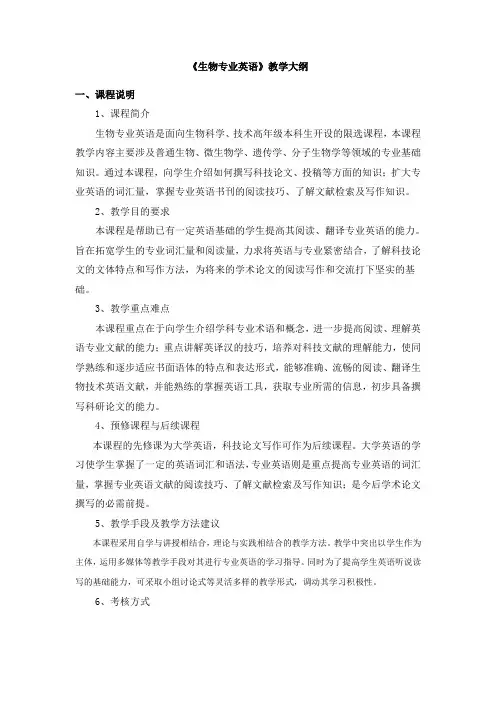
《生物专业英语》教学大纲一、课程说明1、课程简介生物专业英语是面向生物科学、技术高年级本科生开设的限选课程,本课程教学内容主要涉及普通生物、微生物学、遗传学、分子生物学等领域的专业基础知识。
通过本课程,向学生介绍如何撰写科技论文、投稿等方面的知识;扩大专业英语的词汇量,掌握专业英语书刊的阅读技巧、了解文献检索及写作知识。
2、教学目的要求本课程是帮助已有一定英语基础的学生提高其阅读、翻译专业英语的能力。
旨在拓宽学生的专业词汇量和阅读量,力求将英语与专业紧密结合,了解科技论文的文体特点和写作方法,为将来的学术论文的阅读写作和交流打下坚实的基础。
3、教学重点难点本课程重点在于向学生介绍学科专业术语和概念,进一步提高阅读、理解英语专业文献的能力;重点讲解英译汉的技巧,培养对科技文献的理解能力,使同学熟练和逐步适应书面语体的特点和表达形式,能够准确、流畅的阅读、翻译生物技术英语文献,并能熟练的掌握英语工具,获取专业所需的信息,初步具备撰写科研论文的能力。
4、预修课程与后续课程本课程的先修课为大学英语,科技论文写作可作为后续课程。
大学英语的学习使学生掌握了一定的英语词汇和语法,专业英语则是重点提高专业英语的词汇量,掌握专业英语文献的阅读技巧、了解文献检索及写作知识;是今后学术论文撰写的必需前提。
5、教学手段及教学方法建议本课程采用自学与讲授相结合,理论与实践相结合的教学方法。
教学中突出以学生作为主体,运用多媒体等教学手段对其进行专业英语的学习指导。
同时为了提高学生英语听说读写的基础能力,可采取小组讨论式等灵活多样的教学形式,调动其学习积极性。
6、考核方式本课程为考查课,期末开卷考试。
总成绩满分一百分,包括平时成绩占20%+期末考试成绩80%。
7、指定教材蒋悟生主编,生物专业英语(第二版),高等教育出版社,2000年。
8、教学参考书[1] 邬行彦等编,生物工程、生物技术专业英语(第一版),化学工业出版社,2002年。